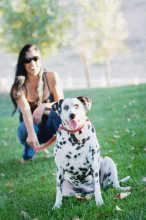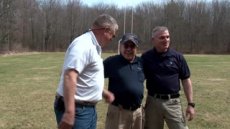i need to train my dog
 People used to think that dog training was only about teaching dogs obedience commands, usually through the use of heavy-handed punishment-based techniques. It was viewed as somewhat of a luxury for pet parents and was often wrongly considered to be something so straightforward and simple to achieve that anyone could do it on their own without the help of a professional.
People used to think that dog training was only about teaching dogs obedience commands, usually through the use of heavy-handed punishment-based techniques. It was viewed as somewhat of a luxury for pet parents and was often wrongly considered to be something so straightforward and simple to achieve that anyone could do it on their own without the help of a professional.
That sentiment does still exist to a degree, but increasingly, dog owners are beginning to recognize that although the profession of dog training is not regulated, there is sometimes life-saving value in finding the perfect trainer to help point them and their dogs in the right direction and provide much-needed guidance.
Science has evolved, and with it the profession of dog training has exploded, but not without controversy. Many traditional trainers that continue to promote outdated dominance and punishment-based philosophies have seen their livelihoods threatened by the ever-growing army of enlightened positive trainers like Victoria's global VSPDT dog trainer network. As a result, dog owners face an increasingly difficult choice when it comes to choosing the right dog trainer.
What is no longer up for debate, however, is that provided you hire a qualified truly positive trainer, any money spent on training will be returned to both you and your dog exponentially in terms of a healthy relationship and a harmonious household.
The fact is that the majority of owned dogs have had no formal training – positive or otherwise. Since dogs are now sharing our homes and our lives in ever closer ways, it is more important than ever that every dog be given a good canine education. Doing so will prevent thousands of dogs being surrendered to shelters due to behavioral issues that could have been prevented. Investing the time to teach your dog will make living with her easier and that investment could also save her life.
5 Reasons Why You Should Train Your Dog
- To Build a Positive Relationship
One of the best ways to build a healthier relationship with your dog is to understand how your dog learns and use the principles of positive training to make learning as rewarding, successful and easy as possible. Punitive trainers believe that in order to achieve so-called ‘balance’ with your dog, you must first teach her who is boss by becoming her ‘alpha’ or ‘pack leader'. This approach is doomed to fail from the start because the methods used to establish this dominant status are physically and psychologically damaging to your dog and dangerous for you.Positive training, which rewards and motivates a dog for good behavior, allows you to foster a relationship with your dog based on mutual trust and respect instead of fear and intimidation. The most effective teachers are those who can influence behavior in their dogs without the use of force and work through any problems in a humane manner. Dogs that are taught using positive reinforcement methods are more tolerant, self-controlled and behave much more predictably in different situations.
The most effective teachers are those who can influence behavior in their dogs without the use of force and work through any problems in a humane manner. Dogs that are taught using positive reinforcement methods are more tolerant, self-controlled and behave much more predictably in different situations.
- To Teach Life Skills
Every dog needs to learn how to live successfully in a home environment. Domestic dogs might seem to have an easy life compared to their wild counterparts, but living in a human world comes with certain unique pressures. Teaching your dog basic manner skills and providing her with enough mental enrichment and physical exercise will prevent her from developing anxiety and other stress related behaviors such as destructive chewing, inappropriate barking and aggressive display.An important part of the learning process is to set your dog up for success by managing her environment and making it easy for her to do well. This begins with understanding how your dog copes in certain situations. For example, if your dog is highly social and loves new people coming into your home, teach her to greet without jumping or overwhelming your guest as they enter. This helps inhibit excitable behavior while still allowing her to enjoy the new person’s arrival.If your dog is wary or fearful of new people, take pressure off her by putting her behind a baby gate or in her own room as they enter. This will help keep stress at bay and your dog emotionally stable. Space is vitally important for dogs that are socially inexperienced or fearful, and managing your environment to reduce pressure keeps everyone happy and safe.
- To Increase Sociability
Increasing your dog’s enjoyment of social interaction will give her the confidence to deal with the pressures of domestic life. Training your dog to have good manners and behave well in different situations requires effort, but consistent commitment ensures success.We have high expectations for our dogs, encouraging them to be friendly with everyone they meet, even if they are uncomfortable in certain situations. It is therefore vital to socialize your dog by giving her good experiences in the presence of all kinds of people, animals and environments. Doing so at a young age will give her confidence and lessen the chance of her experiencing anxiety and discomfort in adulthood.Socialization does not mean your dog has to always physically touch another dog or a person. Humans ‘socialize’ all the time without physically touching each other. Exposing your dog to different situations where she can observe and ‘converse’ at a distance is as important as teaching her to accept physical touch. People are naturally drawn to interact with a cute pup and when dogs greet each other some physical touching is likely to take place.Socialization is all about keeping your dog comfortable in these social situations while taking care not to force her into a situation she might find uncomfortable. If you have the kind of dog that does not interact well with others, do not feel you need to force her. Not all dogs, like people, are social.Understanding how your dog copes will determine how far you can go and even though having a social dog is preferable in our society, it is not a failure to keep your dog out of a situation she finds uncomfortable. Observing how she copes will help you respect and understand her limitations.
Training your dog to have good manners and behave well in different situations requires effort, but consistent commitment ensures success.We have high expectations for our dogs, encouraging them to be friendly with everyone they meet, even if they are uncomfortable in certain situations. It is therefore vital to socialize your dog by giving her good experiences in the presence of all kinds of people, animals and environments. Doing so at a young age will give her confidence and lessen the chance of her experiencing anxiety and discomfort in adulthood.Socialization does not mean your dog has to always physically touch another dog or a person. Humans ‘socialize’ all the time without physically touching each other. Exposing your dog to different situations where she can observe and ‘converse’ at a distance is as important as teaching her to accept physical touch. People are naturally drawn to interact with a cute pup and when dogs greet each other some physical touching is likely to take place.Socialization is all about keeping your dog comfortable in these social situations while taking care not to force her into a situation she might find uncomfortable. If you have the kind of dog that does not interact well with others, do not feel you need to force her. Not all dogs, like people, are social.Understanding how your dog copes will determine how far you can go and even though having a social dog is preferable in our society, it is not a failure to keep your dog out of a situation she finds uncomfortable. Observing how she copes will help you respect and understand her limitations.
- To Avoid Problem Behaviors
Training your dog builds up a language of communication between you that promotes security and comfort. The more time you invest teaching your dog to live successfully in a human world the more you will avoid problem behaviors that come from lack of understanding. Unfortunately, many dogs end up being punished for negative behavior that could have been avoided if time was taken to help them learn.Many dogs respond well to cues such as sit and stay in the classroom, but remain unprepared to deal with life’s pressures in the real world. Make sure that every cue or action has a purpose behind it. Sit is a valuable cue because it can be used before the front door is opened or before crossing a road, while come is a cue that allows your dog to be off leash but teaches her to return to you when you need.Hand targeting or the touch cue, for example, not only helps your dog get used to hands being extended towards her, a scenario she is likely to experience many times in her life, but is also good for teaching a recall.
- For Loyalty and Companionship
Positive reinforcement does not mean you do not mark your dog’s misbehaviors, just that the ‘discipline’ should be used as constructive guidance rather than as an intimidation technique. Discipline in the form of time outs, removal, vocal interrupters or simply ignoring behavior that you do not like, are far more effective than harshly suppressing negative behavior.Guiding your dog into making the right choices and understanding what she needs to be happy will help increase the bond between you.
Related posts:

 Training your dog to do advanced tricks like finding something or bringing their food bowl can be done with just 10 minutes a day and some clicker training. It’s…
Training your dog to do advanced tricks like finding something or bringing their food bowl can be done with just 10 minutes a day and some clicker training. It’s… MARY ISENHOUR-LONG Owner - Trainer Photo by Stewart Event Images About The Trainer The phrase, “gone to the dogs”, is certainly an appropriate one to describe my…
MARY ISENHOUR-LONG Owner - Trainer Photo by Stewart Event Images About The Trainer The phrase, “gone to the dogs”, is certainly an appropriate one to describe my… 6 Principles of Successful Training 1. Be Consistent: Apply the same rules and the same words all the time. 2. Be Concise: Give your command just once. Repetition…
6 Principles of Successful Training 1. Be Consistent: Apply the same rules and the same words all the time. 2. Be Concise: Give your command just once. Repetition… Cesar Millan Cesar is a best-selling author, public speaker, and internationally acclaimed star of the TV shows “Dog Whisperer with Cesar Millan, ” “Leader of the…
Cesar Millan Cesar is a best-selling author, public speaker, and internationally acclaimed star of the TV shows “Dog Whisperer with Cesar Millan, ” “Leader of the… At Monument Dog Training, we believe that change is always possible . We regularly resolve aggressive behavioral issues, even with dogs who have been written off…
At Monument Dog Training, we believe that change is always possible . We regularly resolve aggressive behavioral issues, even with dogs who have been written off…